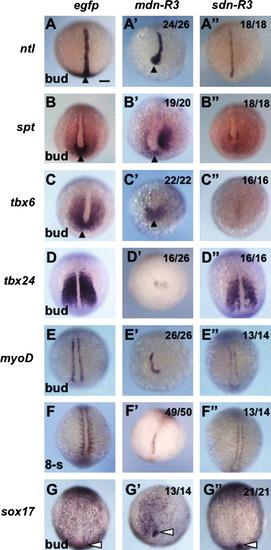Fig. 6
- ID
- ZDB-FIG-090220-14
- Publication
- Ota et al., 2009 - The roles of the FGF signal in zebrafish embryos analyzed using constitutive activation and dominant-negative suppression of different FGF receptors
- Other Figures
- All Figure Page
- Back to All Figure Page
|
Effects of two types of dominant-negative FGFR3c on the mesoderm and endoderm formation at the end of gastrulation. Embryos were injected with mRNA (300 pg/embryo) for egfp, mdn-R3, or sdn-R3, and examined for the expression of mesodermal and endodermal marker genes at the bud stage except for (F–F″), in which expression was examined at the 8-somite stage. Marker expression in the tailbud and forerunner cells are marked with solid and open triangles, respectively. Dorsal views (A, D–G, F′, A″, and D″–G″) or dorsovegetal views (B, C, A′–E′, G′, B″, and C″) with anterior to the top. Rates of embryos with anomalies are shown at the right top. Scale bars, 100 μm. |
Reprinted from Mechanisms of Development, 126(1-2), Ota, S., Tonou-Fujimori, N., and Yamasu, K., The roles of the FGF signal in zebrafish embryos analyzed using constitutive activation and dominant-negative suppression of different FGF receptors, 1-17, Copyright (2009) with permission from Elsevier. Full text @ Mech. Dev.

